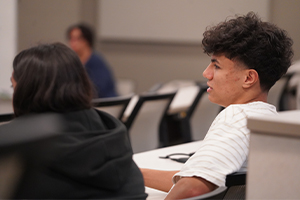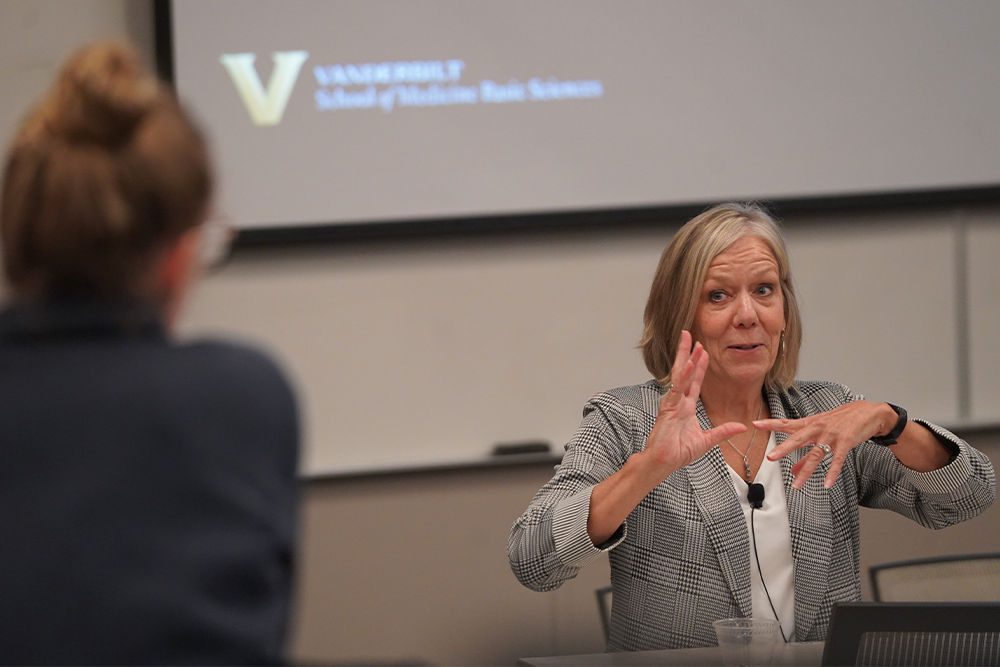A professor from Vanderbilt University recently visited OUWB to talk about the health risks younger people take should they choose to ingest marijuana.
“Cannabis Use and the Developing Adolescent Brain” was presented by Kristen Gilliland, Ph.D., assistant professor of research, Vanderbilt University. She also serves as director of outreach and advocacy programs, Warren Center for Neuroscience Drug Discovery.
During the Oct. 7 presentation, Gilliland drew from her expertise — both personal and professional — to help attendees better understand the risks involved with younger people using marijuana.
Berkley Browne-Holtz, Ph.D., associate dean, Student Affairs & Career Development, said it made sense for Gilliland to address a medical school audience because she “saw the value of our medical students understanding the impact of high-potency cannabis on developing brains, regardless of medical specialty choice. “
“I also really appreciate that Dr. Gilliland's philosophy and approach are rooted in education, not judgment, and I thought it was important for our students to experience that approach to the issue.”
“My hope is that people understand that education is key,” Gilliland said after her presentation. “We need to get out and educate on the risks that are involved with cannabis use, especially during adolescence.”
Deeply personal for presenter
Gilliland started by sharing a deep personal experience she had on the topic.
Specifically, that one of her twin sons, Anders, had social anxiety and started self-medicating with cannabis while in middle school. By 17, Anders started showing symptoms of psychosis. A psychiatrist asked if he had been smoking marijuana.
“He told us about research that showed an association — not a cause but an association — between cannabis use and psychosis,” she said.
Gilliland said that Anders would go on to be diagnosed with schizophrenia and continued self-medicating with a variety of substances.
“On March 4, 2019, I lost my beautiful son to an accidental drug overdose,” said Gilliland.
She said she threw herself into research and educating others because “I had to not let his death be in vain.”
‘A perfect storm’
Gilliland talked about how brains develop (highlighting the impact of repeated stress), neuroplasticity and synaptic pruning, high-potency cannabis and the risks associated with adolescent use, and more.
 |
|---|
| Ahmad Abu-Mahfouz, M2, said he felt "it was super important to be here and be informed about something we’re probably going to be seeing more often.” |
The two primary cannabinoids in cannabis are delta- 9 tetrahydrocannabinol (THC) and cannabidiol (CBD), Gilliland explained. THC is the psychoactive component that causes a person to feel “high” and acts on CB1 receptors in the brain. CBD does not cause a high and has been studied for seizure, anxiety, and opioid withdrawal treatments.
During the last several decades, the potency of THC has increased due to ways cannabis growers have selectively bred plants to maximize THC content and changes in the ways the chemical is processed.
Throughout her presentation, Gilliland underscored that these changes present greater health risks, especially for people under the age of 25.
In short, she said the brain’s plasticity and ongoing maturation make the organ far more susceptible to THC’s harmful effects. The chemical could negatively impact critical neurodevelopmental processes like synaptic pruning, myelination, and the fine tuning of circuits in regions that control decision-making, emotion, memory, and motivation.
Permanent mental health and cognitive issues are among the potential problems identified by Gilliland. She referred to her own son as an example of how THC also may act as a critical trigger for those who have underlying genetic vulnerabilities to conditions like schizophrenia.
“I do believe that there can be a perfect storm,” she said. “Somone who has a predisposition to schizophrenia … cannabis can trigger a psychotic episode.”
‘Best thing we can do’
By travelling to places like OUWB and sharing science and her own experiences, Gilliland said she hopes to empower parents, educators, and young people with the facts they need to make informed decisions.
“The best thing we can do is educate,” she said. “All I want to do is get this information out and in front of as many people as possible.”
Students at the event seemed to indicate Gilliland was successful in her visit to Michigan.
“Given the times that we’re living in right now … we’re really seeing an increase in cannabis use and it’s something we need to be prepared for given that we’re going to be professionals in the medical field,” said Ahmad Abu-Mahfouz, M2. “I felt it was super important to be here and be informed about something we’re probably going to be seeing more often.”
As someone considering pediatrics as a specialty, M2 Vereena Salib said she also thought it was important to attend.
“Before this, I hadn’t really heard much about how the effects (of cannabis) are different in pediatrics versus adults,” she said. “It’s really eye-opening and something I’ll carry into my career.”
M2 Mackenzie Farrow also attended and shared similar thoughts.
“I agree this is something that’s on the rise and we can all see that,” she said. “It’s important for us to be prepared, know how to manage it, and understand the science so we can disperse that information ourselves.”
“I want to be equipped with the right medical knowledge that is backed by scientists and researchers … so I can help.”
For more information, contact Andrew Dietderich, senior marketing specialist, OUWB, at [email protected].
To request an interview, visit the OUWB Communications & Marketing webpage.
This work is licensed under a Creative Commons Attribution-NonCommercial 4.0 International License.








